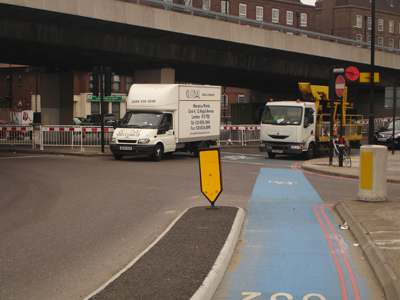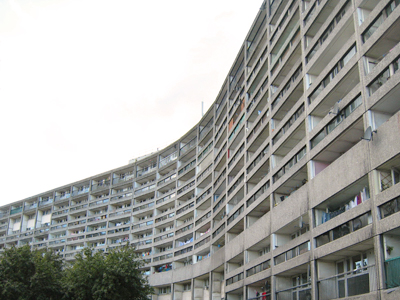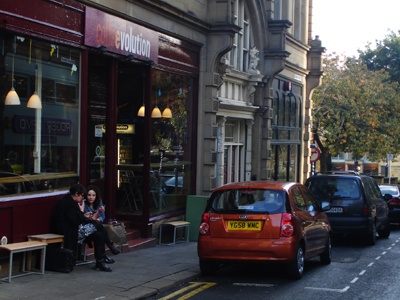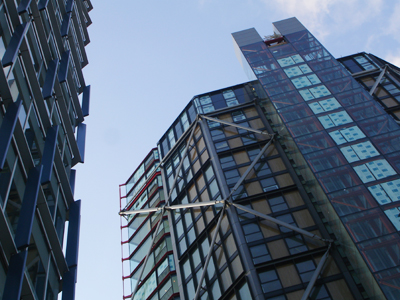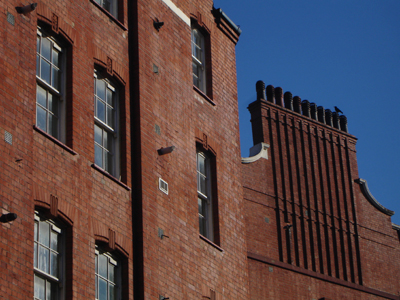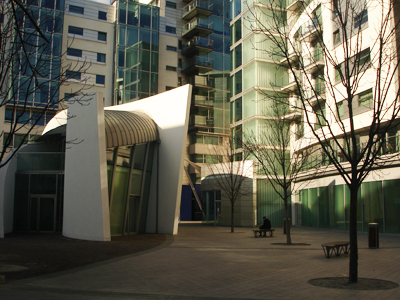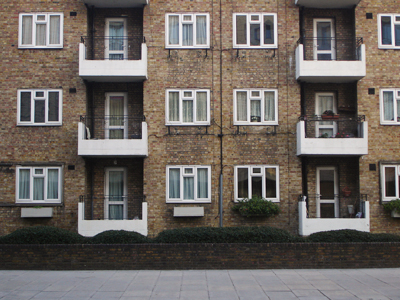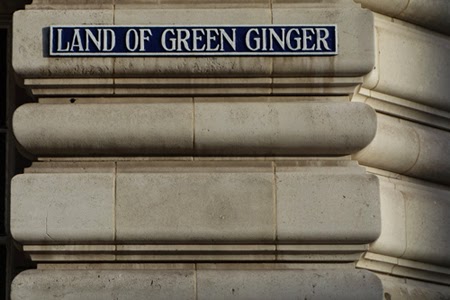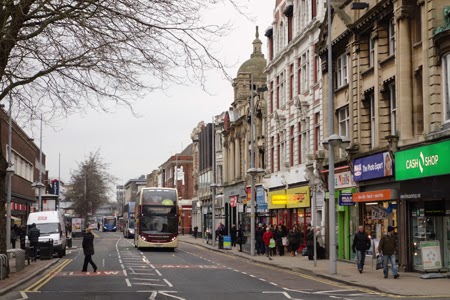
Historic patterns and new technology - there's something in that
After ‘The Killing’ Birger Larsen has moved the action of ‘Murder’ from Copenhagen to Nottingham. He thinks Nottingham is exotic. Well, having blogged about Copenhagen perhaps it is time for us to take a look at our home city. Actually not quite my home city but I was a planner there for 30 years, latterly as Director.

Careful, DH Lawrence might have pissed here - Arkwright Building NTU
When I first arrived in the 1970s I was struck by the strong, independent character of the place, summed up by Ian Nairn as ‘neither Midland nor Northern but with a black veined soul of its own’. Of course your image of Nottingham could not help but be shaped by ‘Saturday Night and Sunday Morning’. Twenty years after Albert Finney’s fine portrayal of Arthur Seaton, and despite massive slum clearance and redevelopment, Nottingham was then still very much the place of Sillitoe’s portrayal; a working class, bolshie city that played hard and took full employment for granted. That was one view of Nottingham anyway; the Council had a more self satisfied picture of the place; it was ‘the Queen of the Midlands’. There is something in that too: the exciting topography, the impressive space of the Old Market Square, a confidence and sometimes grandeur in the buildings. But radical Nottinghamians would subversively preface this soubriquet with ‘the arse of the north and ...’.

The Castle: the real history is more interesting than Robin Hood
Nottingham has never been quite sure of its identity. Bloody Robin Hood has a lot to answer for, or at least Basil Rathbone and Alan Rickman camping it up as the Sheriff of Nottingham. Of course this is impossible to live up to. The merest tarted up fragments of the medieval town remain. The Castle on the dramatic Castle Rock was rebuilt in 1687 as a north Italian palazzo. Burnt down by radicals in the 1831 Reform Act riots it was ineptly restored by the ubiquitous Victorian hack T.C. Hine as the dreariest museum and art gallery you can imagine. The Castle does have its moments though; the fantastic flight of steps up to the magnificent Baroque east façade, and the stupendous view of the Trent Valley.

Ancient streets surviving the numbskull age of the private car
The influence of Errol Flynn’s tights has been quite profound on Nottingham’s view of itself. It clings to the idea that it is a historic city, and yes of course it is albeit re-written by the Victorians. Ian Nairn lamented the destruction of the Stuart and Georgian streets between the Old Market Square and the Castle and some remnants did survive. Castle Gate was restored by the City Council in the 60s, I had assumed out of guilt and remorse at the destruction of the streets around it. Now these fine buildings, formerly used as a museum, are empty, boarded up and on the market as ‘an exciting commercial opportunity’, so I must have been wrong. Byron’s house on St James’s St faces an NCP car park; an interesting juxtaposition, but not conventionally touristy.

Castle Gate: How this was scythed by the following image

Nottingham: an early martyr of highway engineering
Nottingham’s laissez faire attitude to planning, which resulted in the hideous Maid Marian Way and Broadmarsh Centre, came to an abrupt halt in the early 70s. It was replaced by militant conservationism. Public opinion reflected by politicians seemed in a state of shock, a genuine sense of loss for what had been before. The desire to return to a 1950s arcadia became so much the received orthodoxy that there could be no rational discussion. Simon Jenkins spits particular venom at Nottingham today because of the destruction in the 1960s of the city he remembers, visiting the sins of the planners upon their successors unto the third and fourth generation. The problem with this is that it is a sentimentalised and dishonest view of the past. Sillitoe in novels like ‘The Loneliness of the Long Distance Runner’ shows us why Nottingham needed to change. Coates and Silburn paint a damning picture in their seminal study of St Ann’s before its redevelopment, ‘Poverty, the Forgotten Englishman’.

Extending pedestrianisation northward at Old Market Square

Somewhere in a parallel universe, Cloughie became Prime Minister
Conservationism and the Robin Hood delusion are actually part of a wider Nottingham psychosis - its reluctance to be a big city. It was made a City in 1897, not because it asked to be one but Bradford and Hull, with typical Yorkshire bumptiousness, were pressing for city status and the civil servants realised that Nottingham was actually larger. Earlier the town had refused to expand beyond its medieval boundaries onto the common fields until 1845, leading to fearful overcrowded slums and leaving a pernicious legacy of slum housing into the mid C20th. This led to the heroic if flawed massive clearance and redevelopment in the 60s and 70s. There was a further fateful consequence too – when in the 1920s Nottingham sought to expand its boundaries to include the burbs, they successfully pointed to the City’s slum problems. The boundary extension was not approved and the City did not try again. Instead it built the pompous Council House completed in 1929. Designed by the Council’s architect Cecil Howitt as Elain Harwood points out it displays all the classical tastes of the day. The interior is beautifully appointed like a gentleman’s club, which it was - the antithesis of the ‘People’s Palaces’ town halls of the 1930s. The suburbs are still politically separate, not real places at all but defined by NOT being part of the City. This profoundly debilitates the capacity of Nottingham to think and act as the city it actually is, a clearly defined urban area of about 600,000 people.

Jubilee phase I - nice, though a long way from the world of Arthur Seaton
Nottingham, an industrial city, took a huge knock when mad monetarism closed down much of its industry. Because of its broad industrial base, this came later than in Sheffield and other northern towns and was less dramatic and visible. There were not huge swathes of derelict heavy industry, but lots of empty factories. The basis of the working class city changed irrevocably, so much so that Nottingham now has less manufacturing employment than the national average. Arthur Seaton famously said ‘don’t let the bastards grind you down’, but global capitalism did. The Raleigh factory where he worked is demolished. The bikes are imported from China and the factory site is now the Jubilee campus of Nottingham University, which has many Chinese students and a campus in Ningbo; as neat a metaphor for economic change as you could find.

Boots: A modernist masterpiece - if you can get past security
Boots, always synonymous with Nottingham, has not only survived but prospered in the global economy but with a very different culture to the patrician company which commissioned wonderful buildings at its Beeston fiefdom. This is an area the size of Monaco to which you won’t get access, which is a pity because the Owen Williams buildings are just stupendous and the 60s SOM HQ is to die for. Nearby the Players Horizon factory by Arup is heroic.

Standing up to central government - The Inland Revenue building

A public street not dominated by car parking but shame about G4S
Nottingham’s reaction to de-industrialisation was not go for development at all costs. It did not court regeneration, like Manchester or Birmingham, nor did it just lie back and let it happen, like Leeds or Southampton. Its bravest decision was rejecting the government’s bog standard design and build for the new Inland Revenue HQ, resulting in a design competition won by Michael Hopkins. I think the result is outstanding, particularly the confident plan with almost collegiate spaces between the buildings not dominated by car parking – a scheme far ahead of its time. More generally the City took a basically reactive and sceptical approach to development, keen not to compromise its self image as the ‘Queen of the Midlands’. In this it was not entirely successful as the most cursory exploration will show. But things could have been a lot worse if the development industry had really been interested in Nottingham, which it wasn’t.

Wasteland Eastside: Now twinned with other neoliberal disasters
Landowners and regeneration quangos dreamt grand schemes but not much came of them. The former Boots works at Island St provides a good insight. Promoted by the private sector over 20 years ago as a mini Canary Wharf (which we nicknamed Budgie Wharf), decontamination and infrastructure were publically funded through City Challenge but only a few business park type offices and cheap hotels materialised. Then in the Blair boom another hugely ambitious plan for offices and now including apartments with vibrant mixed uses, on an even bigger site including derelict railway warehouses. Years of negotiation ensued, a bonanza for consultants: environmental impact assessment (in large boxes), flood risk assessments, masterplan, design codes, listed building consents, highways agreements, waterway agreements, affordable housing, S106 and phasing plans. Nothing happened. And then came the siren of Tesco as regeneration enabler; not a shed as you know it but seductively cloaked by Mangera Yvars. To its credit the Council said no. The site is still a wasteland, the warehouses pathetically derelict, and there is no plan.

Southreef: still incomplete because the financial world is failing us

Another utterly incompetent building from Jurys Inn
Elsewhere regeneration was more successful, such as along the Nottingham Canal. Here you will find some impressive schemes including Hopkins’s Inland Revenue, Castle Wharf by Franklin Ellis, offices by ORMS (now occupied by the Council) and Southreef by Levitate; a clever and satisfying mixed use design for a very difficult site, but sadly showing the fragility of the local market as the developer can’t seem to complete it. Opposite this Jury’s Inn displays its usual sensitivity, although this was not entirely the architect’s fault – the Planning Committee wanted it to be more ‘iconic’. Yes, well.

The admirable aesthetics of a once paternalist city - Highfields Park
A huge driver of the new economy has been Nottingham’s two universities, THE Nottingham University (TNU) and Nottingham Trent University (NTU); one a Russell and the other ex Poly; both highly successful. The City was slow to appreciate the economic importance of the universities but the impact of 50,000 students became a big problem in the terraced streets of Lenton in particular – Nottingham’s version of gentrification. The only real solution to this is to promote new student housing blocks but this is a notoriously difficult design typology. The barracks flats of Radford are nothing to be proud of but at least the more recent developments are making an effort.

The Hallward Library TNU: Wow but the interior has been buggered

Jubilee phase II features the most pointless bridge in town
TNU’s rolling parkland campus began in the 20s with Portland stone and moved on to surprisingly good neo Georgian in the 50s (both underscoring the conservative nature of the institution) before a convincing shot at Brutalism. The first phase of a second 'Jubilee' campus on the old Raleigh factory site was designed by Michael Hopkins and, like his Inland Revenue HQ, is a carefully considered, quietly confident and slightly flawed essay in sustainable design, ideal you would have thought for a university with a strong sustainable energy and construction reputation. But evidently it was not jazzy enough for a university competing in a global market. The second phase is by Make. There is no point in my competing with Owen Hatherley’s coruscating denunciation of this in his book ‘Ruins’. To my shame I was the officer on the planning bridge when this happened.

NTU renewal - sorting out the courtyard mess

From awkward corner to public space
Meanwhile NTU was trying to make sense of its disjointed city centre buildings, including the original university Arkwright Building designed by Lockwood and Mawson in 1877. Howitt’s amazing Stalinist tower in Portland stone, the Newton Building, was built as late as 1958. Both are listed but needed huge investment and new functions. Hopkins again was called in and his solution – a very elegant glazed atrium between the two buildings and a new quad - provides a focus for the whole campus. However this eminently sensible and carefully considered design resulted in a titanic struggle with English Heritage over such Jesuitical niceties of procedures as would try the patience of someone much less hot tempered than me. Eventually the scheme was splendidly executed. In its latest commission NTU have gone for an Alsop-esque eye catcher.

Inequality & security are close relations - The Park Estate

Inner city bourgeois charm - unusual for industrial England
As elsewhere the transition to a service economy in Nottingham has been at the expense of the working class, job security and social cohesion. This is not immediately obvious because inequality is most pronounced in the extensive sub garden city banlieue rather than in the sometimes too dynamic inner city. Unusually too for an English industrial city the haute bourgeoisie live right next to the city centre in the Park Estate, a Victorian gated community. Birger Larsen chose Nottingham for ‘Murder’ because of its edgy reputation, a fiction which becomes self fulfilling by tabloid repetition. Actually the place is not that exotic but it is interesting. Areas like Sneinton (unpronounceable) retain a fascinating village like feel which defies gentrification. Hyson Green once notorious for its deck access flats has reemerged as an interesting multi cultural area with inviting Asian supermarkets and independent shops. The New Art Exchange by Hawkins Brown is the first regional arts centre devoted to promoting ethnic and minority arts. Along Gregory Boulevard is Foster’s Djanogly City Academy, elegantly cool; a big statement for the area if not one I approve of.

Sneinton: Defying gentrification - through civic responsibility (and poverty)

One of the most interesting high streets in the city - Radford Road

The best samosas in town mate - Hyson Green
Like most cities there is a lot of poverty alongside conspicuous wealth. This relentless alienation of the dispossessed is painfully captured in Shane Meadows’s films, so much so that I can hardly bear to watch. A more nuanced view of the city can be seen in ‘Weekend’ directed by Andrew Haigh, a sort of gay ‘Brief Encounter’ where they actually get to do it. This is shot to give amazing new perspectives of the city you thought you knew; a really insightful and delightful film.

Greener than any Legoland estate - Lenton Flats

Popular with residents so what's the problem?
The action in ‘Weekend’ revolves around the Lenton flats, tower blocks built in the 60s which form an attractive composition in long views together with the topography and landscape. They were part of the massive programme of high rise and deck access developments of that era in Nottingham which had one of the largest clearance programmes in the country. In the 70s over half the homes in Nottingham were Council houses or flats, but within a few years the deck access flats were being written off as a disaster and demolished. The Thatcher view of Council housing as failure is pervasive. Problems are perceived with all typologies of Council housing even if Alice Coleman’s theories are easily disproved by a visit to garden city inspired estates built between the wars, where the worst problems of deprivation are to be found. It is not the houses, it is poverty and lack of opportunity. But poor maintenance and management are used to justify a ‘knock it down and start again’ solution and this sadly seems now to be the fate of the Lenton flats, although how this can be sustainable or economically sensible is hard to see.

The Edwardian dinosaur
The parting in ‘Weekend’ takes place at Nottingham Station against disembodied announcements – ‘24 hour security is in operation at this station; please do not leave your luggage unattended as it may be removed or destroyed by the security staff’ - brilliantly capturing the anomie of the place. Nottingham Station has been almost as peripheral to the privatised rail industry as Carnforth but this grand Edwardian dinosaur is finally being renovated and extended thanks to the persistence of the City and Nottingham Development Enterprise, which also promoted the Nottingham tram. This took 15 years of nagging the government until finally Prescott gave in – but it was worth it. By far the handsomest tram in Britain, care was taken in its integration with the streetscape of the city centre, unlike other cities where engineers ran amok. Two new tram lines are currently being constructed from the Station. Now NDE is folding because of lack of funding, another victim of Coalition Britain’s cluelessness.

Perhaps the best new art gallery and tram in Britain

Taming the expressway for people - Maid Marion Way today
Although Nottingham has always lacked a clear planning vision, it is strongly focused when it comes to transport policy. In the early 70s the City scrapped plans for new highways and introduced traffic restraint and public transport priorities far ahead of its time. In 1998 the City became a unitary authority again with a radical transport agenda at a time when Prescott was turning on the funding tap. It is the only city to have introduced a tax on workplace parking spaces – a lot of fuss about that but it has been done and funds the new tram lines. Courageous schemes like closing a whole section of the inner ring road had strong political support and Nottingham has done a lot to make the city centre pedestrian-friendly, getting rid of nearly all the subways and creating new public spaces. However, although high quality materials are (mostly) used street design lacks flair, certainly compared with Leicester. The Campaign for Better Transport ranks Nottingham as the least car dependent city after London and Brighton. Nottingham’s use of public transport is the highest outside London; three times higher than in Bristol, a similar sized conurbation.

More of this please: pedestrian and cycle improvements in Hockley

And less of this: The Broadmarsh gyratory
But on leaving the Station you will soon discover the grim face of Nottingham. Your route to the city centre is blocked by the execrable Broadmarsh Centre, the area dominated by roaring ring road traffic, the buildings and townscape the meanest it is possible to imagine. And this at the principal entrance to the city centre, overlooked by the Castle and the Lace Market, a shocking indictment of Nottingham and its incapacity to shape its own destiny. Birmingham’s 60s Bull Ring presented similar complicated challenges, but Birmingham had the vision and determination to change the situation. Nottingham now has more empty shops than any major town, or so Today says, based on the usual dodgy data.

An insult to the Castle and the Lace Market cliff - Broadmarsh
Nottingham was unfortunate in that Westfield, or Wastefield as it is known in Bradford, bought the centre and spent 10 years developing ever grander plans for redevelopment. In retrospect these plans look like prototypes for White City; alien, alarming and anti-urban. All the Design Review in the world cannot wash away the damage such a flawed concept will inflict on a city. And yet we are expected to believe that the Olympic Westfield is a triumph of regeneration. In some ways Nottingham was lucky that Wastefield pulled the plug last year but the City now waits on the new shopping centre owners, who have appointed mall specialists Benoy to come up with a scaled down scheme. So the future of the city centre will be determined in board rooms far away, not by Nottingham.

An urban balls up - Trinity Square
The contemporaneous Victoria shopping centre has always been more confident and successful than Broadmarsh. Although dismissed as a concrete eyesore it has wonderfully sculptural Council flats above which if viewed enfilade look like an expressionist liner. It is a pity the flats have been painted blue and pink in an attempt to make the concrete look cosier. Worse is the plan to further extend the shopping centre as an inward looking box such as even Westfield would no longer dare. Across the way the new Trinity Square development is violently hated, a good example of the fallacy that redevelopment of 60s buildings will necessarily be an improvement.Design guru Peter Bishop says this is one of the worst new developments he has seen. Cheapjack and over scaled certainly but I think he needs to get out more; the small new public space is actually well used despite its crass paving. There is currently a competition to improve it, which seems very much like fiddling whilst Broadmarsh burns. Looming over Trinity Square the new E-on HQ currently under construction makes itself ridiculous by trying to disguise its bulk with a crude curved roof defering to the redundant Victorian Guildhall next door. Down the street the interesting 30s police and fire stations are apparently doomed.

The people are always more interesting than the "events" - Old Market Success
The friendly and generally attractive city centre streets radiate from the Old Market Square, after Trafalgar Square the largest in England and the spiritual heart of Nottingham. The market was turfed out when the Council House was built and Howitt redesigned it as a formal ‘Slab Square’. A highlight of my career was (with NDE) to get Nottingham to accept a redesign of the Square, which went against its conservative instincts. The winning scheme designed by Gustafson Porter is, in my clearly prejudiced view, a stunning triumph of elegance and functionality, although not achieved without glitches and tears. It has been hugely popular with Nottinghamians; so many children play in the water features that life guards have had to be employed. One of the great pleasures is to sit quietly admiring the space and people watch. Unfortunately there is an obsession with staging events so that you can hardly ever fully appreciate the space without a clutter of extraneous crap. The latest threat is a monstrous TV screen on one of the buildings. What sort of moron would inflict that on the ‘Queen of the Midlands’?

In the 60s the local Tories had alternative plans for a car park
Despite a general conservatism and complacency in planning, Nottingham has been willing to take brave decisions, sometimes. Peter Moro’s Playhouse was one of those back in 1961. More recently the Planning Committee unanimously supported Adam Caruso’s Nottingham Contemporary despite the yellow press. Almost braver was its support of Benson and Forsyth’s uncompromisingly Modernist hotel and shops at Fletcher Gate in the Lace Market, intelligently commissioned by local developer Bildurn. This brilliantly broke all the conventional platitudes of the planning brief for the site. But generally Nottingham was content to be reactive, which I found very frustrating. I remember once showing some planning bigwigs around the City, explaining what was wrong and what needed to be done and one of them said ‘do you like anything about Nottingham?' Well yes, but it could be so much better if only….

Tramlines and De Stijl squares - Benson & Forsyth's The Pod
But militant conservationism has its good points. The Lace Market is a case study. This unique area, where grand Victorian warehouses crowd narrow medieval streets and collide with the elegance of the C18th around the magnificent C15th St Mary’s church, was virtually derelict by the 1970s. Its restoration is a great success story of perseverance, but it is a Forth Bridge job. The Lace Market is once again in decline, burned by the recession. The fashion trade has gone, many of the creative industries have folded or moved, city living has lost its glamour and the once hedonistic night life has been tamed by a new authoritarianism. The new Lace Market Square, with imaginative artwork and landscaping by Fiona Heron, has not managed to let its restaurants and bars. WW2 bomb sites remain undeveloped and no solution can be found for the remaining derelict buildings. It is the morning after the night before. The new City Deal for Nottingham includes vague plans for a ‘cultural quarter’ in the Lace Market and nearby Sneinton Market; standard regeneration issue. But Nottingham does at least have a strong artistic tradition and maybe its edgy reputation is not always a liability. Sneinton Market has recently been handsomely if slightly austerely redesigned by Patel Taylor and Sneinton Baths splendidly rebuilt by Levitate, retaining the Victorian tower. The infrastructure is there, but needs animation.

Sneinton Market - handsome, if slightly austere
When I first came to Nottingham it was a confident, independent minded city. Now like the rest of industrial England it is a client and supplicant of Whitehall, the City of London and globalisation. It has not helped that Nottingham has been slow to perceive and define a new role for itself, but in any event it lacks power, political and economic. This is really evident in planning and housing. What the city needs is family housing but in the Blair-Brown boom years what it got was a deluge of bog standard buy to let speculative flats, mostly repeating the design and (lack of) management mistakes of the recently demolished Council flats. If Nottingham got off lightly compared to places like Leeds, this was largely down to the determined opposition of Councillors. What Nottingham also needs is real jobs in industries such as construction and green technology, where there is significant local strength.

Marsh house - the Meadows

Green Street - the beginning of better inner-city housing?

New bridge connecting canal towpath to riverside path

The Big Track & Victoria Embankment - a cycling and public realm triumph
A much more comprehensive account of Nottingham is found in the outstanding Pevsner City Guide by Elain Harwood who comes from Nottingham, ok Beeston.
Ken Powell’s Nottingham Transformed (Merrell) written in 2006 before the world turned upside down (or rather before we noticed) deals expansively with the developments of the last two decades.
Owen Hatherley’s chapter in his ‘Guide to the New Ruins of Great Britain’ (Verso) lays bare the reality that is Nottingham today.

























































































































































































































































































































